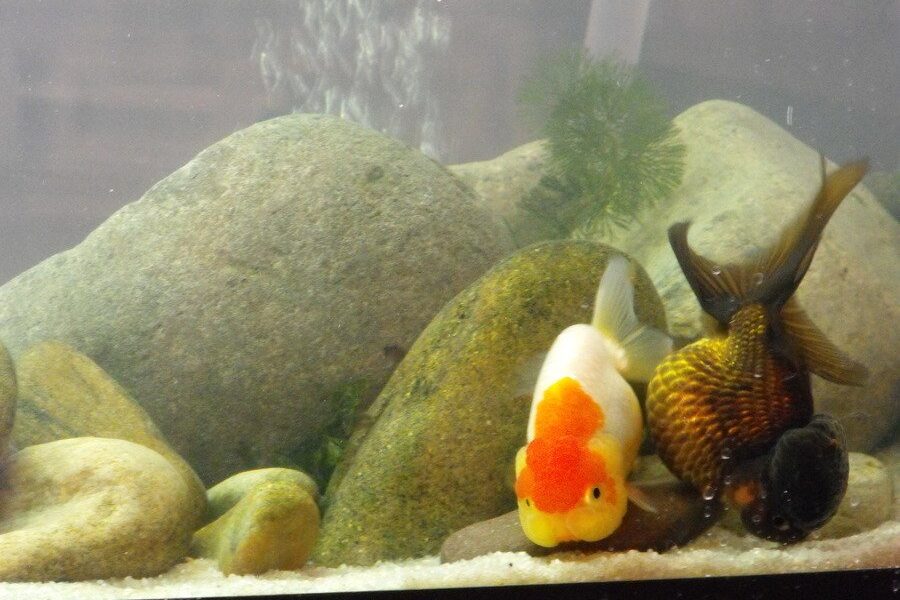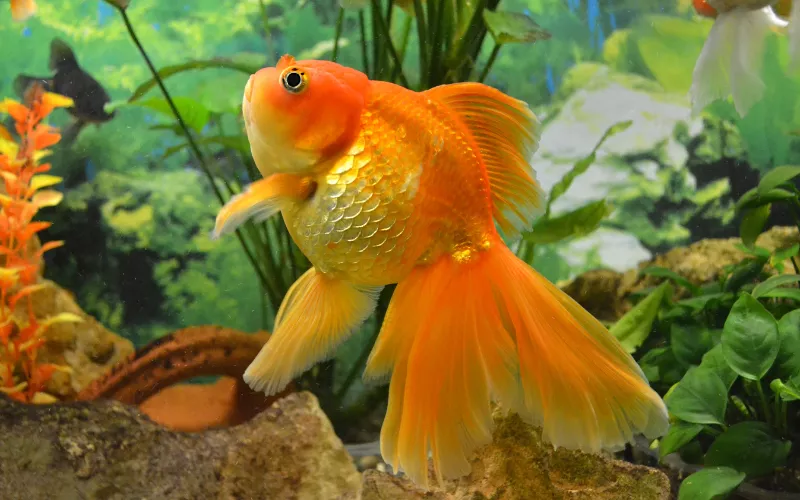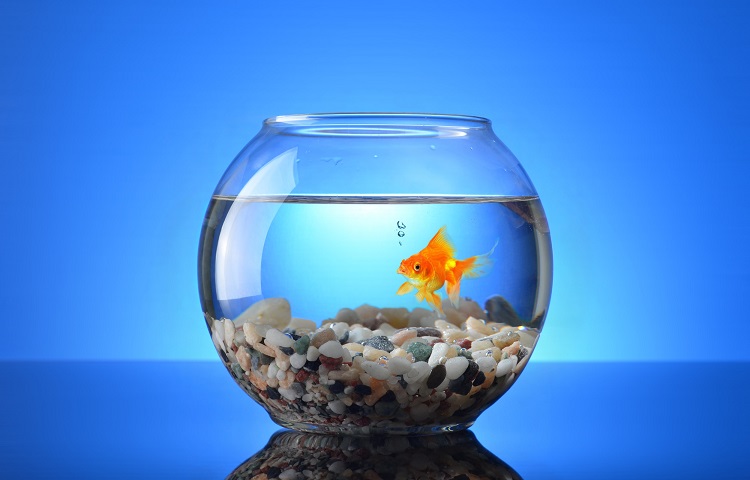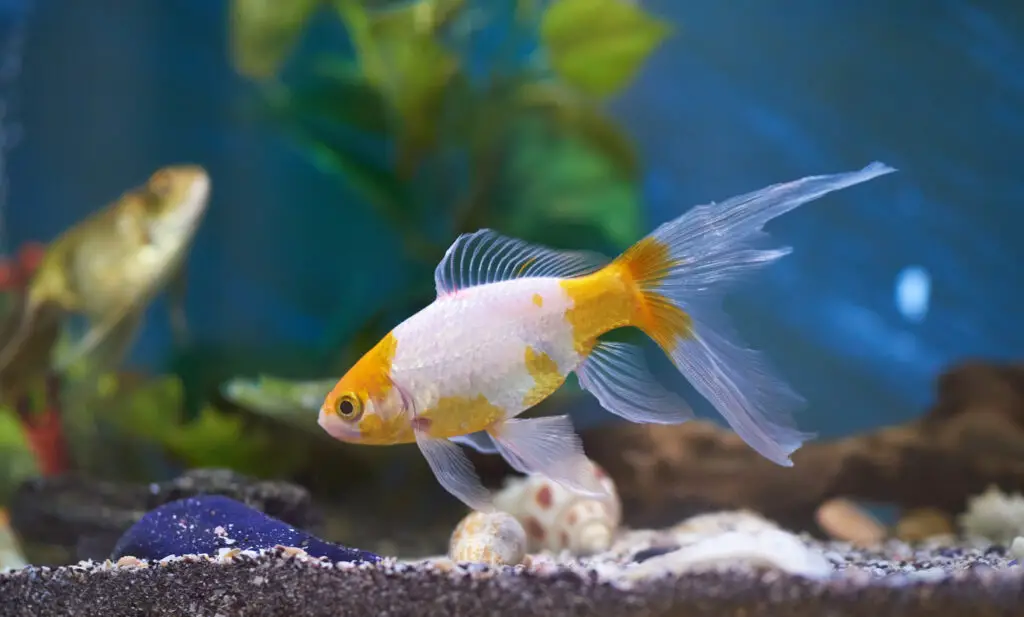
“Goldfish Changing to White” may sound like the latest magic trick or a peculiarly niche sci-fi movie, but it’s actually a common quandary puzzling goldfish enthusiasts worldwide. These charming, shimmering creatures, despite their name, don’t always come in just gold. They can pull off a veritable rainbow of hues, sometimes even deciding to go au naturel and turn white.
Whether you’re a seasoned goldfish aficionado or an aspiring one, keeping a goldfish is not just about providing a glass castle for them to swim around. It’s about understanding their mood swings, their dietary preferences, and their fashion trends – yes, this includes their sudden sartorial choice to switch from gold to a minimalist white. So strap in, because we’re about to dive deep into the fascinating world of goldfish color change, or as we like to call it, “The Goldfish White Out.”
The Appeal of Goldfish as Pets
There’s a lot to adore about these glittering little creatures. From their vibrant coloration to the playful ambience they bring to any room, it’s no wonder goldfish are often the pet of choice. They don’t come with the constant commitment of a dog or the arrogance of a cat, ahem… Tallulah! In fact, they’re among the most budget-friendly and easiest pets to own – provided that they’re adequately cared for.
Goldfish are like unexpectedly profound poets, their silence speaks volumes about life – for anyone willing to stop and observe. So, whether it’s because they can’t overeat the houseplants or because someone in your house is allergic to everything with fur, I get it. Goldfish rock!
The Importance of Proper Goldfish Care
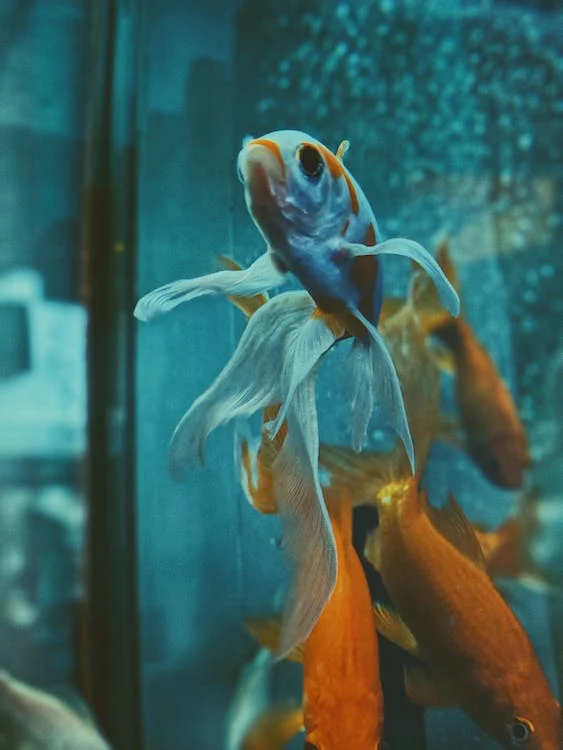
However, here’s the tea, even with their simple needs, goldfish do require proper care and attention. To fully enjoy their bright colors and happy flitting about, it’s crucial to ensure their comfort in an optimal environment. I like to think of it as maintaining the best “Goldfish MTV Cribs”. After all, even aquatic rock stars deserve good digs.
From maintaining the pH of the water to providing a balanced diet (P.S Cherry pie is a no-go), correct goldfish care is integral for their happiness and health – and colorful displays. But what happens when your shining, radiant goldfish lose their color and turn white? It’s a mystery as fascinating as why socks disappear in the dryer!
Fear not, keep reading! It won’t require a Sherlock Holmes hat or a magnifying glass. In this article, we will dive deep (no pun intended!) into the potential causes of this color-changing caper and discuss preventative measures for happy, colorful goldfish. So grab your detective gear, let’s jump to the next section – normal coloration of goldfish. You’ll be a Goldfish Guru in no time!
Normal Coloration of Goldfish
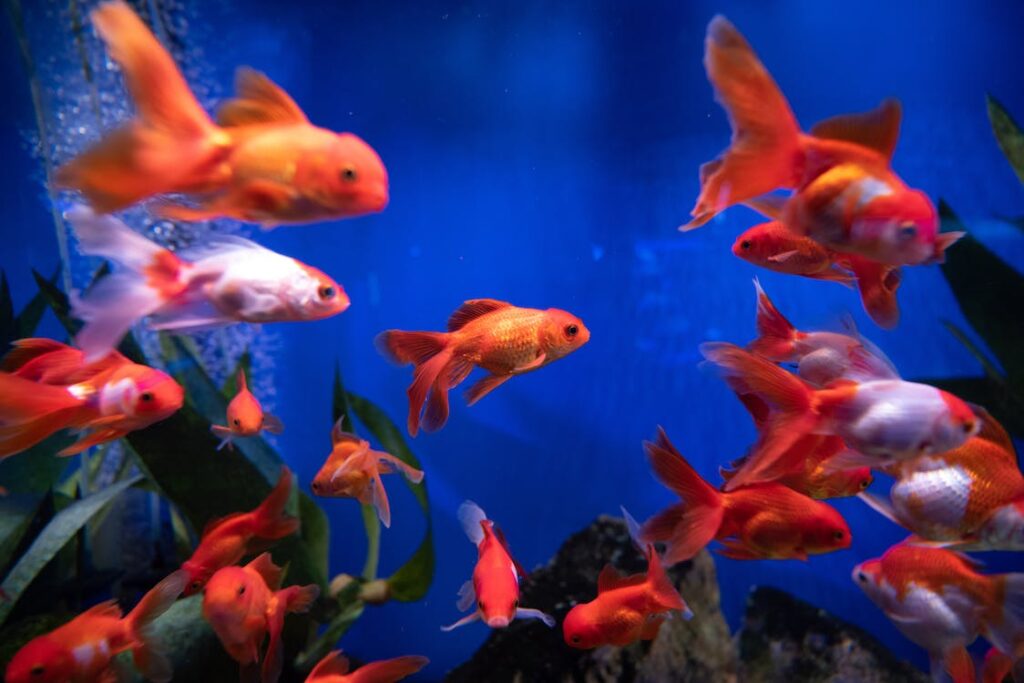
Before we plunge deeper into the ocean of white-goldfish mysteries, let’s first get ourselves familiar with what’s “normal” for these water-world wonders.
Understanding The Natural Color Variations in Goldfish
Goldfish are like aquatic chameleons, boasting an array of colors – not just gold. Thanks to extensive breeding over the years, goldfish can display shimmering shades of red, orange, yellow, black, white, and even purple (fancy that!). They can be one color all over, have tricolor patches, or wear a blend of shades that would put a rainbow to shame.
The unique color of your goldfish can change as they age and all the different colors are natural. When they’re young, they might don a little black suit of scales, which as they age could change into a regal gold or blushing orange. So, simply put, witnessing your goldfish change color could be the equivalent of their ‘awkward’ teenage phase. Nothing to worry about – they are just fish-figuring life out.
However, the complete loss of color that leaves your goldfish resembling Casper, the friendly ghost is not routine color transformation. This could indicate something more serious, which brings us to differentiating between normal color changes and abnormalities.
Differentiating Between Color Changes and Abnormalities
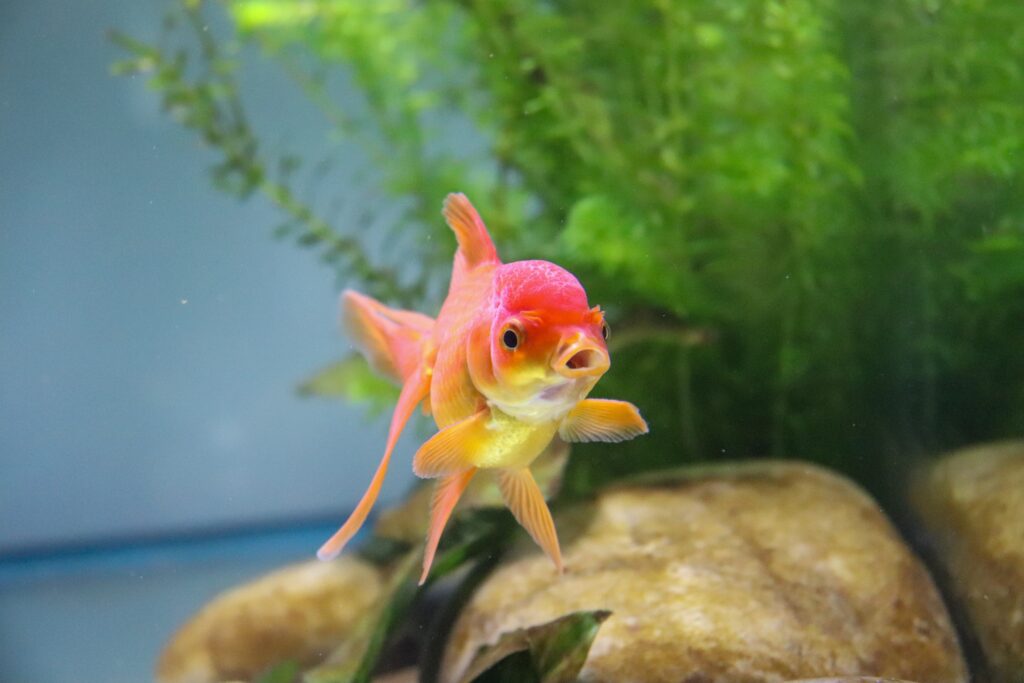
While your goldfish changing colors might give you a mini aquarium-fashion show, it’s vital to know when the transformation is a catwalk or a cause for concern. Change in color, like the transition from black to gold, is normal and an anticipated part of aging.
But if your goldfish is turning white rapidly or developing white patches, spots, or streaks, it’s about as normal as a fish riding a bicycle. This isn’t usual aging or color morphing. It signals underlying issues such as stress, infection, or poor water quality sabotaging your fish’s once vibrant color.
So, how do you tell obvious color transformation from potential issues that can make you scream “someone get Nemo a doctor!”? Well, that’s our next stop on this mystery-solving journey. Buckle up as we prepare to dive into the potential causes of your goldfish’s sudden impersonation of Moby Dick.
Potential Causes for Goldfish Changing to White
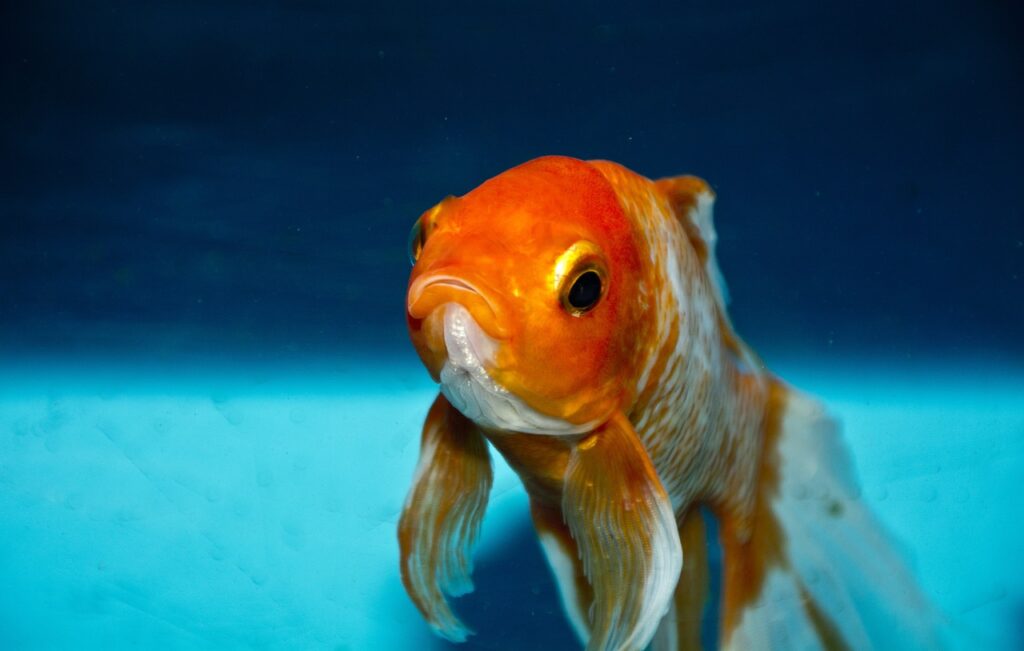
Why do goldfish pull a chameleon and turn white? Goldfish, like humans, have their share of issues and not all involve forgetting what happened 3 seconds ago. Let’s delve into three potential perpetrators at the scene of the crime: stress, infections, and water quality.
Stress-induced Loss of Pigmentation
We all know that stress can turn human hair white – apparently we share this tendency with our aquatic friends too. Bandit, your goldfish, isn’t robbing banks at night, but changes in his environment can cause a significant amount of stress. This stress can result in him losing his gold pigmentation and going incognito into the white scene. Chronic stress can affect Bandit in many forms, such as rapid changes in water temperature, overpopulation in the tank, or improper nutrition. So, patience, my friends, is key! Avoid any sudden changes in Bandit’s living conditions to keep the gold in your goldfish.
Now, let’s paddle our way into something itchier. No, it’s not about your aunt’s wool sweater. It’s about fungal or bacterial infections!
Fungal or Bacterial Infections
Our golden pets aren’t immune to feeling under the weather. Certain types of fungal or bacterial infections can cause your goldfish to develop white patches, making him look more like a cow than a fish. Infections may be present if color changes are accompanied by changes in behavior or other symptoms like spots or lesions. Winston Churchill once said, “A fish does not know it’s a fish until it is out of water.” Trust me, your fish will feel the itch and will show signs if he’s not feeling well. It’s your job to learn, observe, and act upon those signs.
Having plunged into infections, let’s venture into water quality, and no, we’re not talking about the murky water body you hesitated to jump into last summer.
Water Quality Issues Affecting Coloration
Water quality plays a paramount role in maintaining the vibrance of your pet’s color. A dive into poor water conditions—low oxygen levels, improper pH, high ammonia or nitrate content—can turn your goldfish’s scales whiter than Casper the Friendly Ghost. Maintaining pristine water conditions is as essential as your morning cup of coffee.
Now that we’re knee-deep in the common culprits of your little swimmer’s color change, let’s learn how each one of them individually can blast away the gold from your goldfish.
Stress-induced Loss of Pigmentation
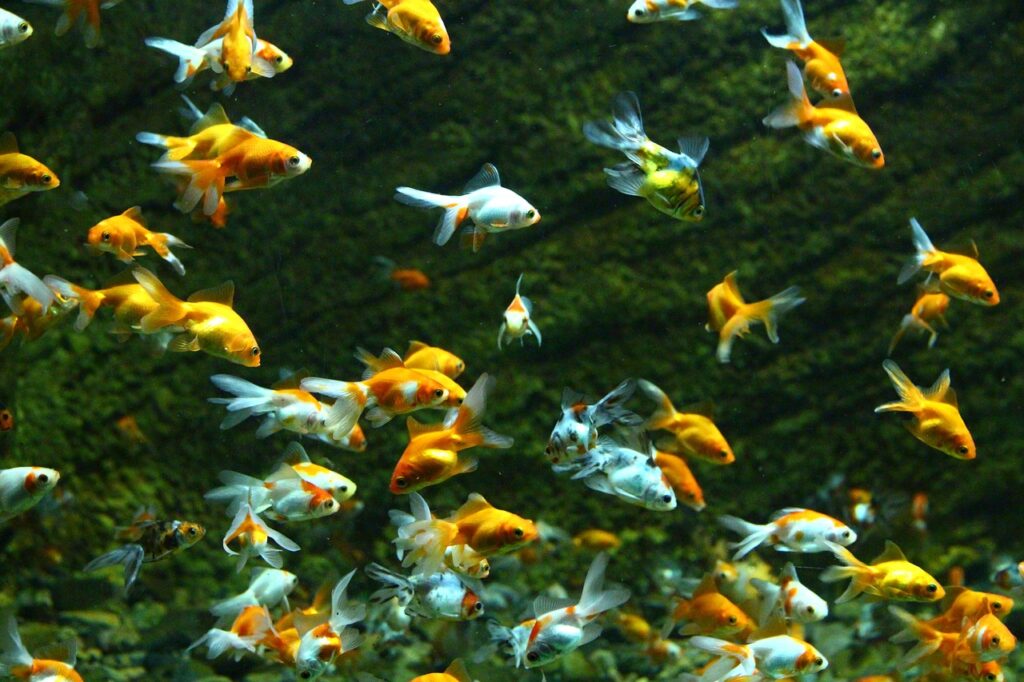
Ever wondered if your goldfish could benefit from a yoga class or some deep-sea meditation? Sounds fishy, right? Fins down, it’s simpler than that. Our aquatic friends struggle with stress too, and, believe it or not, it’s likely to change their color. Let’s dive in.
How Stress Can Impact Goldfish Coloration
Here’s a surprising fact: stress can make your golddigger lose its luster. No, your goldfish isn’t pulling a reverse-Midas on you by turning from gold to colorless – stress is just having the upper fin. High-stress levels can cause the fish’s body to prioritize other functions over pigment production, leading to them turning white. Usually, this arises from factors like an unsuitable environment, improper diet, or the annoying cousin your goldfish can’t swim away from (Yes, fish can have poor roommates too).
Now that we’ve given you the down-low on stress whitewash let’s move onto soothing those frazzled fishy nerves. Trust us; this won’t involve playing Enya on loop beside the fishbowl, although you’re welcome to try!
Tips for Reducing Stress in Goldfish
Reducing stress in your goldfish is easier than you’d think and doesn’t involve any pet therapist. First, provide them with enough space to swim freely – remember, they’re adventurers at heart. Second, maintain a clean, well-oxygenated water environment by regularly changing a percentage of the water and using appropriate filters. Third, ensure a balanced and varied diet, because nothing says ‘stress’ like another day of the same bland flake!
Lastly, try not to overcrowd the tank. Goldfish are social but not all the time; they like to have their own swimming space. Plus, let’s face it — all gatherings are stressful, even underwater.
Having learned how to keep their swimming sanctuary stress-free, it’s time for a deep dive into another probable cause. Brace yourself, we’re about to face (and fight) the bacteria and fungi lurking in the watery shadows of your goldfish tank.
Fungal or Bacterial Infections
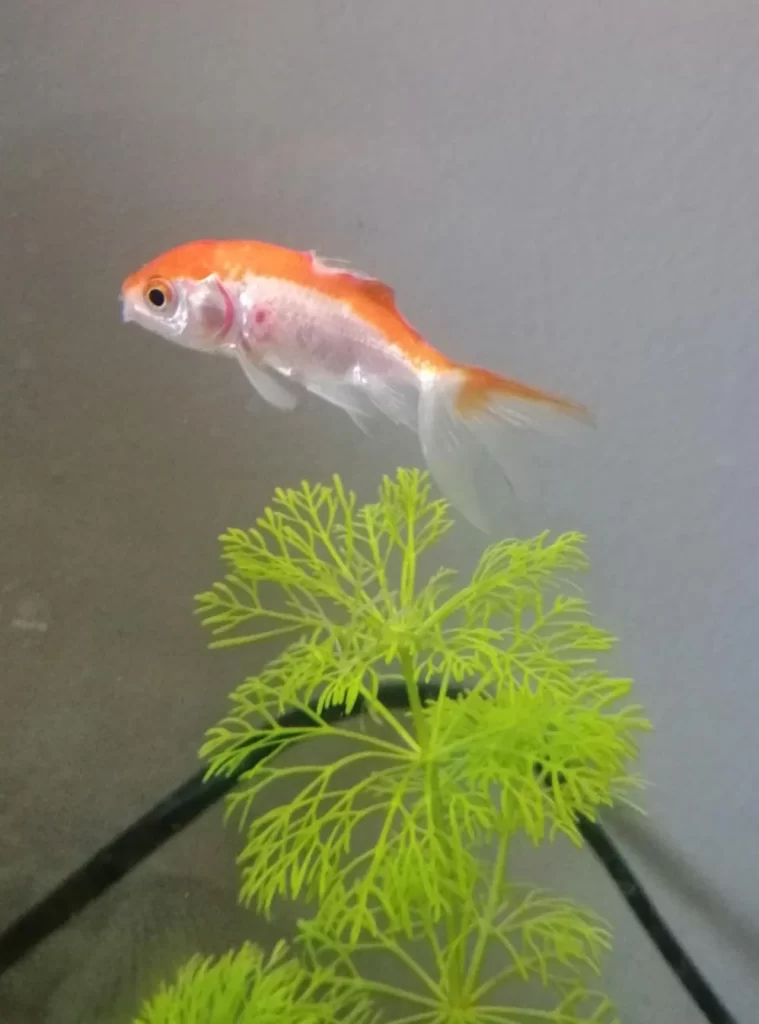
Among the many reasons why goldfish may don a white, not-so-alluring color could be due to some unwanted guests – fungal or bacterial infections. These party poopers often result in white patches on your goldfish, different from them trying to be a fashion trendsetter by naturally changing color.
Common Infections That May Cause White Patches
A fungal infection called Saprolegnia is one common culprit that could make your goldfish turn into a snowy scene. These fungi latch onto your goldfish, usually in response to another health issue (it’s the ultimate drama queen). Bacterial Infections, such as columnaris, can also cause white spots, often accompanied by fuzzy tufts.
Let’s not forget about the infamous Ich or white spot disease (Ichthyophthirius multifiliis if you want to impress at trivia night.) This microscopic parasite causes tiny white spots, much like Goldie decided to play connect-the-dots on their own skin.
All these unwelcome lodgers can cause goldfish skin color to fade or develop unsightly white patches, hence, consistent monitoring should be part of your goldfish parenting routine.
Treatment Options for Fungal or Bacterial Infections
So, you’ve found the underbelly of the iceberg. You’re staring at a funky fungus or blighty bacteria causing your goldfish to fade away like an old photograph. What do you do, hotshot? Well, relax, because there are many treatment options available and we’ve got plenty of weapons in our armory against these micro marauders.
Fungal infections like Saprolegnia are usually treated with antifungal medication that can be added to the tank. So, it’s not Rocket Science! Over-the-counter therapies are a go-to first step, just follow the provided instructions to avoid creating a serial killer for your other fishies.
In the unfortunate case of bacterial infections, antibiotics are the knight in shining armour. If Goldie’s got the itch, there are several ich treatments available- these are typically liquid that you’d add to the water.
Regardless of the treatment, it’s important to diagnose the issue properly. Misdiagnosis can lead to improper treatments, which can cause Goldie to swim up to that big aquarium in the sky.
Dive into the next section to see how the quality of water in your fish tank can also be a Secret Agent for white coloration. Understanding what’s happening underwater can give you the detailed field report you need to ensure your goldfish is living their best teeming life.
Water Quality Issues

Ever taken a bath in mucky, grime-laden water? Didn’t think so! And neither do your goldfish like it. In fact, poor water condition is the sneakiest thief of your fishy friend’s enchanting hues.
The Impact of Poor Water Conditions on Goldfish Color
Water quality in a goldfish tank is like air quality to humans; when it’s off, everything’s off. Goldfish are susceptible to subpar living conditions and poor water quality is often a leading cause of color change. ‘Dirt’ in this context isn’t just your garden variety of sediment floating around but also includes toxins like ammonia and heavy metals, too much or too little salt, and the wrong pH balance. All these and more can participate in the whitening of your once vibrant goldfish.
Imagine moving from a tree-filled countryside into a smoke-filled city; the change in the atmosphere could cause issues, right? The same applies to your goldfish moving from perfect, clear water to a murky, toxin-filled equivalent. Their color fades into white as a call for help!
Expecting the incoming points of ‘How to maintain optimal water quality’? Good! Your goldfish are happy about your enthusiasm and curiosity. They may not show it right away but believe me, they are.
Steps to Maintain Optimal Water Quality
No need for a full-blown CSI investigation here! Keeping your tank in top condition involves a few key steps.
First, regular (as in weekly) water changes are vital, but remember, it’s not about changing all the water but about a quarter to keep nutrients intact. Second, invest in a quality aquarium filter to take care of unwanted toxins. Third, keep an eye on the pH balance – goldfish thrive between 6.0 to 8.0 pH. Urge to test water conditions? Use a water test kit for this purpose!
Lastly, rein in overfeeding. Yes, looking at you, who thinks feeding your fish five times a day is love. Goldfish are like hungry toddlers who don’t know when to stop. Overfeeding can lead to excess food and faeces, which messes up the water balance faster than you can say ‘goldfish’.
Ready to dive into the world of preventing white coloration in goldfish completely? Let’s keep swimming!
Preventing Goldfish Changing to White
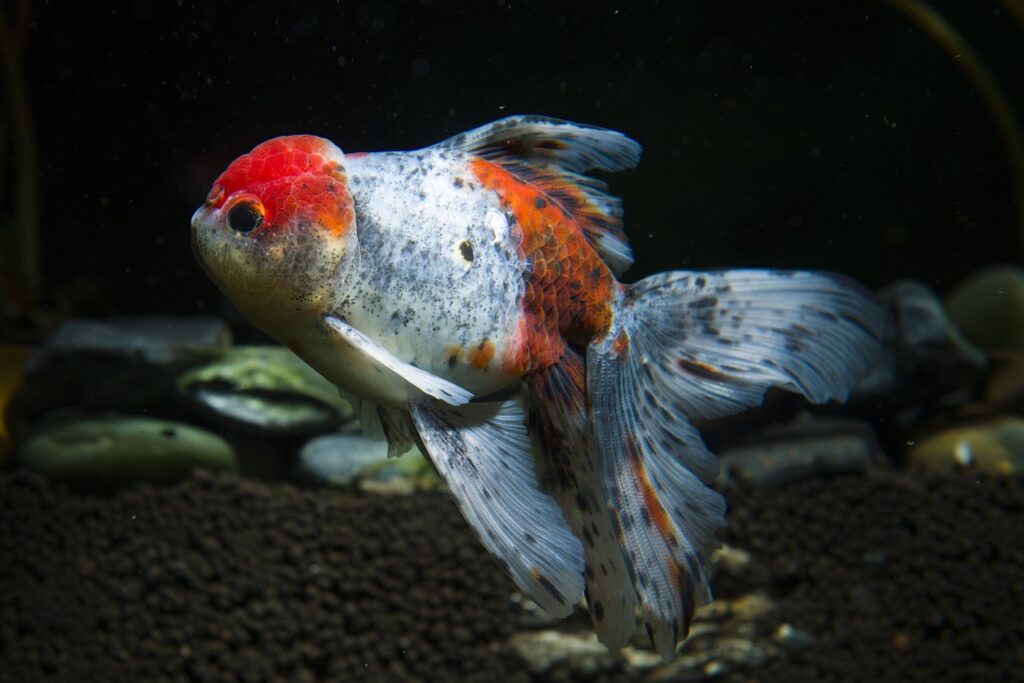
We’ve already chatted about the many ‘not-so-fantastic’ reasons why your goldfish might be turning as pale as a ghost. It’s all been a bit doom and gloom, right? Well, buckle up, because it’s time to switch gears and take a more optimistic approach. Let’s delve into useful tips and practices to stop your goldfish from losing their colorful allure and becoming more like Casper the Friendly Ghost.
Providing a Balanced Diet for Vibrant Color
You know how people say you’re what you eat? It´s the same with goldfish! If you feed your pet a balanced diet that’s chock-full of nutritious goodies, they’ll glow like a tiny underwater rainbow. Be sure to sprinkle in some high-quality flakes or pellets, live food (yum, worms), and vegetables. Yes, you heard it right, your adorable little water puppies also need their greens. By investing in a nutritionally complete diet, you won’t just maintain their dazzling color, but you’ll make sure they’re healthier and happier too. And isn’t that what all fish-parents want?
Now, to make sure your goldies don’t lose their glitter, let’s create a zen haven for them to thrive in.
Creating a Stress-Free Environment
There’s nothing fish enjoy more than chilling out in a stress-free environment, just floating around and doing their fishy thing. Consider adding plants and rocks to your tank to give it a natural look and feel. This gives your fish places to hide when they’re feeling shy or just need a little “me time”. Who knew fish were such introverts?!
Ensure you have enough space in your tank too. Cramming too many fish into one tank is like throwing a never-ending house party. Everyone gets annoyed, the neighbors complain, and no-one gets any sleep. And stressed fish often lose color. So make sure your golden babies have plenty of room to roam.
Swap the house party for a tranquil, serene spa-like environment, and you’re sure to thwart any color loss in your goldfish. Now, let’s make that spa an oasis.
Maintaining Clean and Well-Filtered Water

Imagine you had to live in your bathroom for your entire life, and it never got cleaned. Gross, right? In similar fashion, lack of clean water isn’t exactly a day at the beach for your fish either. A dirty tank can be a Pandora’s Box of parasites, bacteria, and diseases. Yuck! And guess what? Yep, you’ve guessed it, it can cause your goldfish to turn white as the driven snow.
Keep your goldfish tank cleaner than a hound’s tooth. Regular water changes and a good filter can keep those nasty little impurities at bay. This will not only help your fish retain their dazzling color but also write off potential diseases that can cause color loss.
And that just about wraps up our little color-keeping tutorial! But hold your seahorses; we’re not done yet. It’s time for some final words of wisdom.
So, there you have it. A roadmap to maintaining those flashy goldfish colors everyone loves. It might not always be as easy as swimming downstream, but sometimes taking care of our little underwater buddies requires a bit more depth. Literally! Once you master these steps, your goldfish will be sparkling with vibrance, and you’ll better understand their needs.
Wrap Up
The Importance of Proactive Goldfish Care
As we’ve merrily floated through the sea of goldfish care, it’s evident that these little glittering buddies are not just aesthetic additions to our homes. They’re living creatures that require attention, care, and commitment (No, they’re not your ex, but catch my drift?).
Being proactive is at the helm of superb goldfish care. It’s not about waiting for your pet to transform into an albino lookalike before you act. Why? You just don’t wait till you start resembling a raisin before you drink water, right? See, hydration is key for you as much as proactive care is for your fish buddy.
Remember, that timely check on water conditions, a careful assessment of their diet, and stressing less than a yoga practitioner can help maintain their vibrancy and ensure they steer clear of the white coloration pitfall.
With that said, let’s not forget that sometimes, despite your best efforts, your fish might still hit a discolored patch, and that brings us to the next crucial point.
Seeking Veterinary Advice If White Coloration Persists
Who ya gonna call? Ghostbusters – um, no. Vetbusters! Yep, when your goldfish are turning more white than a 90’s boy band music video, it’s time to pull out the big guns.
A vet, specifically, one specializing in aquatic pets, can help shed light on this perplexing conundrum like a lighthouse does for lost ships. Sometimes, the coloration changes could be unsolvable Scooby-Doo mysteries that need an expert hand.
Persistence is key, whether you’re arm-wrestling a gorilla or dealing with your fish. If the white color refuses to budge like a stubborn donkey, a vet visit is non-negotiable—not to alarm you, but it might be a signal of underlying problems that Google or any blog (including this one, sigh!) can’t solve.
That being said, folks, care for your goldfish like a superstar, shower them with love and not with overfeeding, remember Uncle Vet is one call away, and stay swimming!
And remember, a goldfish adds not only beauty but a sense of tranquility to your space. The least we can do is reciprocate by ensuring they live a vibrant and healthy life.
If this doesn’t make you the ultimate Goldfish Guardian, I don’t know what will! Until then, happy fish-keeping.. or should I say gold-keeping?
Frequently Asked Questions (FAQ)
Question 1: Why is my goldfish turning white?
Answer: Goldfish can turn white due to stress, fungal or bacterial infections, or poor water conditions leading to loss of pigmentation.
Question 2: Can goldfish change color naturally?
Answer: Yes, goldfish can naturally change color due to aging, genetics, or environmental factors. However, they should not change to an unhealthy looking white.
Question 3: Can stress cause my goldfish to turn white?
Answer: Yes, intense stress can cause a goldfish to lose pigmentation, resulting in a color change.
Question 4: How can I reduce my goldfish’s stress levels?
Answer: You can reduce stress by maintaining optimal water conditions, providing a balanced diet, and creating a harmonious environment.
Question 5: Could a bacterial or fungal infection cause white patches on my goldfish?
Answer: Yes, goldfish can develop white patches due to certain fungal and bacterial infections.
Question 6: What can I do if I suspect my goldfish has an infection?
Answer: You should seek help from a professional or a veterinarian. There are specific medicines available to treat fungal or bacterial infections in fish.
Question 7: How does water quality impact my goldfish’s color?
Answer: Poor water conditions often lead to stress and disease in goldfish, resulting in a loss in pigmentation and vibrant color.
Question 8: What can I do to prevent my goldfish from turning white?
Answer: Maintain clean, well-filtered water, provide a balanced diet, create a stress-free environment, and act quickly if you suspect any health issues.
Question 9: Should I consult a vet if my goldfish turns white?
Answer: Yes, if your goldfish turned white and none of your efforts are helping, then it’s advisable to seek veterinary advice as white coloration may indicate a serious health issue.

